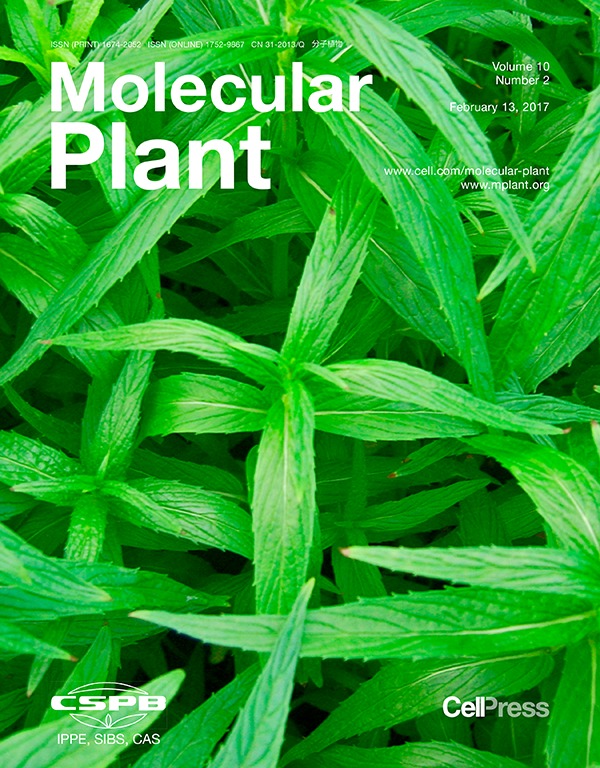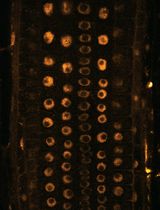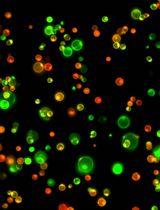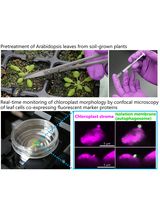- EN - English
- CN - 中文
Transient Expression Assay in NahG Arabidopsis Plants Using Agrobacterium tumefaciens
使用根癌农杆菌在NahG拟南芥植株中进行瞬时表达分析
发布: 2018年06月20日第8卷第12期 DOI: 10.21769/BioProtoc.2894 浏览次数: 9696
评审: Zhibing LaiAraceli Castillo GarrigaShunping Yan
Abstract
Agrobacterium-mediated transient expression has greatly contributed to research in molecular plant biology but has low efficiency and inconsistency in Arabidopsis thaliana (Arabidopsis). Here, we describe a simple, efficient and fast protocol to make transient gene expression in NahG Arabidopsis plants using Agrobacterium tumefaciens. This protocol has been successfully used to assess protein sub-cellular localization and accumulation, enzyme activity, and protein-protein interaction. In addition, this assay overcomes the use of Nicotiana benthamiana plants as a surrogate system for transient gene expression assays. Finally, the use of this protocol does not require complex inoculation methods or specific growth conditions, and can be used with different Agrobacterium strains with similar results.
Keywords: NahG Arabidopsis (NahG拟南芥)Background
Agrobacterium tumefaciens (hereafter referred to as Agrobacterium)-mediated transient transformation assays have greatly contributed to research in molecular plant biology. These methods have many advantages over the laborious and time-consuming stable transformation approaches including, among others, a higher efficiency, simplicity, and fast, consistent results when the transient transformation assays are carried out in Nicotiana benthamiana. On the other hand, these assays are inefficient and lack robustness when carried out in the model plant Arabidopsis thaliana (hereafter referred to as Arabidopsis), forcing Arabidopsis researchers to use N. benthamiana as a heterologous system, which entails obvious limitations and might generate misleading results.
Many efforts have been made in the past to increase the efficacy of Agrobacterium-mediated transient transformation in Arabidopsis (reviewed in Krenek et al., 2015). Recently, we described a protocol to perform transient gene expression using NahG Arabidopsis plants, overcoming previous limitations (Rosas-Díaz et al., 2017). Using Arabidopsis NahG plants, which contain low levels of salicylic acid (SA) due to the expression of an SA hydroxylase from the bacterium Pseudomonas putida (Lawton et al., 1995), we have been able to obtain high accumulation of marker proteins such as GUS and GFP, and carry out sub-cellular localization and protein-protein interaction experiments. Remarkably, this protocol for transient expression can be used with, at least, three widely used Agrobacterium strains, LBA4404, GV3101 and C58C1. In summary, this protocol shows that expression of the NahG transgene greatly enhances the efficiency of Agrobacterium-mediated transformation in rosette leaves in Arabidopsis, enabling the routine use of this technique in the model plant.
Materials and Reagents
- Materials
- Soil mix or substrate such as Compo Sana® Universal Ligera (COMPO, TSUSTPROF25L)
- Plant pots such as Desch vol 11 (Desch Plantpak, catalog number: 1055278 )
- Seed tray–40 cavities
- Plant trays
- Cling film
- Syringes 1 ml or 2 ml
- Tissue paper
- Petri dishes
- Falcon tubes
- Eppendorf tubes
- Pipette tips
- Sterile toothpicks
- Syringe filter 0.22 µm
- Soil mix or substrate such as Compo Sana® Universal Ligera (COMPO, TSUSTPROF25L)
- Biological materials
- Arabidopsis thaliana NahG seeds (Lawton et al., 1995)
- Agrobacterium tumefaciens strain (LBA4404, GV3101 or C58C1) carrying a binary vector with the gene of interest
- Arabidopsis thaliana NahG seeds (Lawton et al., 1995)
- Reagents
- Sterile deionized water
- Glycerol (CARLO ERBA Reagents, catalog number: 453752 )
- NaCl (AppliChem, catalog number: 121659.1210 )
- Tryptone (Biolife, catalog number: 412290 )
- Yeast Extract (AppliChem, catalog number: 403687.1210 )
- Bacteriological agar (MICROKIT, catalog number: BCB006+ )
- MES (2-(N-morpholino) ethanesulfonic acid) (Sigma-Aldrich, catalog number: M2933 )
- MgCl2 (AppliChem, catalog number: 131396.1210 )
- DMSO (Sigma-Aldrich, catalog number: M81802 )
- Acetosyringone (Sigma-Aldrich, catalog number: D134406 )
- Rifampicin (Duchefa Biochemie, catalog number: R0146.0005 )
- Tetracycline (Sigma-Aldrich, catalog number: T3383 )
- Gentamycin (Sigma-Aldrich, catalog number: G3632 )
- Spectinomycin (Duchefa Biochemie, catalog number: S0188.0005 )
- Kanamycin (Sigma-Aldrich, catalog number: K4378 )
- LB medium (see Recipes)
- 1 M MES (see Recipes)
- 1 M MgCl2 (see Recipes)
- 0.1 M Acetosyringone (see Recipes)
- Infiltration solution (see Recipes)
- Antibiotics solution (depending on construct and Agrobacterium strain, see Recipes)
- Sterile deionized water
Equipment
- Sterile Erlenmeyer flasks
- Plant growth chamber capable of sustaining 21 °C under short-day conditions (8 h light/16 h dark) with 140-150 µmol m-2 sec-1 light intensity (Radiber SA, catalog number: AGP-1400 )
- Spectrophotometer capable of OD600 measurements such as Shimadzu UV-1601 (Shimadzu, catalog number: 206-67001-34 )
- Automatic P1000, P200 and P20 micropipettes
- Incubator set at 28 °C such as Incubator D-6450 Hanau (Heraeus Instruments, model: D-6450 )
- Incubator shaker capable of sustaining 28 °C and 180 rpm such as New BrunswickTM I26 (Eppendorf, New Brunswick scientific, model: I26, catalog number: M1324-0000 )
- Centrifuge for 50 ml tubes such as Rotofix 32A (Hettich, catalog number: 1206-01 )
- Autoclave
Procedure
文章信息
版权信息
© 2018 The Authors; exclusive licensee Bio-protocol LLC.
如何引用
Cana-Quijada, P., Bejarano, E. R., Lozano-Durán, R. and Rosas-Díaz, T. (2018). Transient Expression Assay in NahG Arabidopsis Plants Using Agrobacterium tumefaciens. Bio-protocol 8(12): e2894. DOI: 10.21769/BioProtoc.2894.
分类
植物科学 > 植物生理学 > 生物胁迫
细胞生物学 > 细胞成像 > 共聚焦显微镜
系统生物学 > 相互作用组 > 蛋白质-配体相互作用
您对这篇实验方法有问题吗?
在此处发布您的问题,我们将邀请本文作者来回答。同时,我们会将您的问题发布到Bio-protocol Exchange,以便寻求社区成员的帮助。
提问指南
+ 问题描述
写下详细的问题描述,包括所有有助于他人回答您问题的信息(例如实验过程、条件和相关图像等)。
Share
Bluesky
X
Copy link



.jpg)










